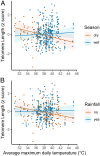Hot and dry conditions predict shorter nestling telomeres in an endangered songbird: Implications for population persistence
- PMID: 35696588
- PMCID: PMC9231487
- DOI: 10.1073/pnas.2122944119
Hot and dry conditions predict shorter nestling telomeres in an endangered songbird: Implications for population persistence
Abstract
Climate warming is increasingly exposing wildlife to sublethal high temperatures, which may lead to chronic impacts and reduced fitness. Telomere length (TL) may link heat exposure to fitness, particularly at early-life stages, because developing organisms are especially vulnerable to adverse conditions, adversity can shorten telomeres, and TL predicts fitness. Here, we quantify how climatic and environmental conditions during early life are associated with TL in nestlings of wild purple-crowned fairy-wrens (Malurus coronatus), endangered songbirds of the monsoonal tropics. We found that higher average maximum air temperature (range 31 to 45 °C) during the nestling period was associated with shorter early-life TL. This effect was mitigated by water availability (i.e., during the wet season, with rainfall), but independent of other pertinent environmental conditions, implicating a direct effect of heat exposure. Models incorporating existing information that shorter early-life TL predicts shorter lifespan and reduced fitness showed that shorter TL under projected warming scenarios could lead to population decline across plausible future water availability scenarios. However, if TL is assumed to be an adaptive trait, population viability could be maintained through evolution. These results are concerning because the capacity to change breeding phenology to coincide with increased water availability appears limited, and the evolutionary potential of TL is unknown. Thus, sublethal climate warming effects early in life may have repercussions beyond individual fitness, extending to population persistence. Incorporating the delayed reproductive costs associated with sublethal heat exposure early in life is necessary for understanding future population dynamics with climate change.
Keywords: climate change; early life; fitness; telomere.
Conflict of interest statement
The authors declare no competing interest.
Figures



Similar articles
-
Cool, dry nights and short heatwaves during growth result in longer telomeres in temperate songbird nestlings.Mol Ecol. 2023 Oct;32(19):5382-5393. doi: 10.1111/mec.17107. Epub 2023 Aug 22. Mol Ecol. 2023. PMID: 37606092
-
When does early-life telomere length predict survival? A case study and meta-analysis.Mol Ecol. 2023 Jun;32(11):3000-3013. doi: 10.1111/mec.16894. Epub 2023 Mar 7. Mol Ecol. 2023. PMID: 36811398
-
Early-life telomere length predicts lifespan and lifetime reproductive success in a wild bird.Mol Ecol. 2019 Mar;28(5):1127-1137. doi: 10.1111/mec.15002. Mol Ecol. 2019. PMID: 30592345
-
Telomere dynamic in humans and animals: Review and perspectives in environmental toxicology.Environ Int. 2019 Oct;131:105025. doi: 10.1016/j.envint.2019.105025. Epub 2019 Jul 25. Environ Int. 2019. PMID: 31352262 Review.
-
[Accelerated telomere erosion in schizophrenia: A literature review].Encephale. 2021 Aug;47(4):369-375. doi: 10.1016/j.encep.2020.12.001. Epub 2021 Apr 15. Encephale. 2021. PMID: 33863507 Review. French.
Cited by
-
Linking telomere dynamics to evolution, life history and environmental change: perspectives, predictions and problems.Biogerontology. 2024 Apr;25(2):301-311. doi: 10.1007/s10522-023-10081-8. Epub 2024 Jan 22. Biogerontology. 2024. PMID: 38252370 Free PMC article. Review.
-
Early-life telomere length predicts life-history strategy and reproductive senescence in a threatened wild songbird.Mol Ecol. 2023 Jul;32(14):4031-4043. doi: 10.1111/mec.16981. Epub 2023 May 12. Mol Ecol. 2023. PMID: 37173827 Free PMC article.
-
Cooperative breeding does not mitigate declines in offspring care with cool and wet conditions in a temperate Australian songbird.R Soc Open Sci. 2025 Mar 5;12(3):250020. doi: 10.1098/rsos.250020. eCollection 2025 Mar. R Soc Open Sci. 2025. PMID: 40420847 Free PMC article.
-
Telomere DNA length regulation is influenced by seasonal temperature differences in short-lived but not in long-lived reef-building corals.Nat Commun. 2023 Jun 1;14(1):3038. doi: 10.1038/s41467-023-38499-1. Nat Commun. 2023. PMID: 37263999 Free PMC article.
-
A future food boom rescues the negative effects of early-life adversity on adult lifespan in a small mammal.Proc Biol Sci. 2024 Apr 30;291(2021):20232681. doi: 10.1098/rspb.2023.2681. Epub 2024 Apr 24. Proc Biol Sci. 2024. PMID: 38654643 Free PMC article.
References
-
- Lane J. E., Kruuk L. E. B., Charmantier A., Murie J. O., Dobson F. S., Delayed phenology and reduced fitness associated with climate change in a wild hibernator. Nature 489, 554–557 (2012). - PubMed
-
- Walther G.-R., et al. , Ecological responses to recent climate change. Nature 416, 389–395 (2002). - PubMed
Publication types
MeSH terms
Substances
LinkOut - more resources
Full Text Sources
Medical

